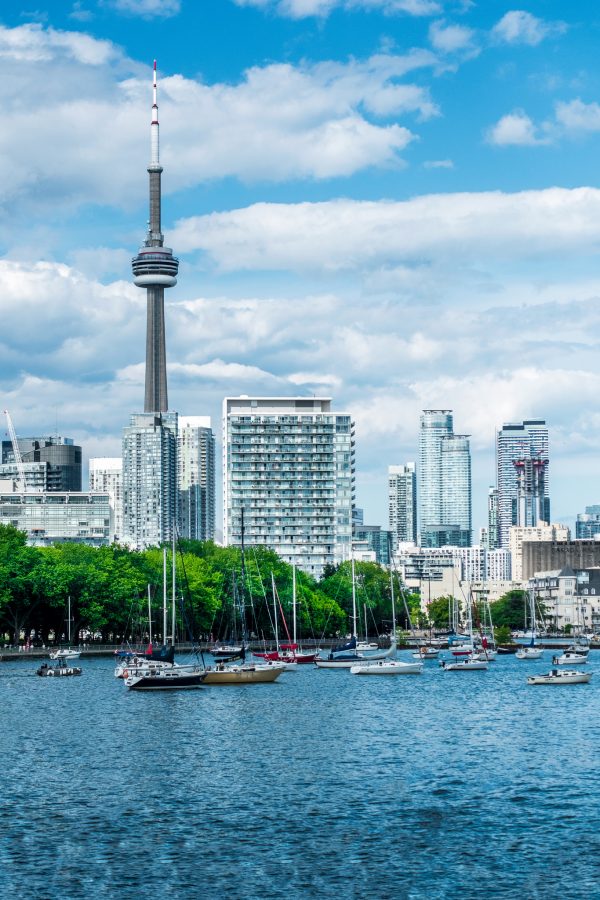Glittering skyscrapers, old mansions, picturesque parks, museums, theaters and stadiums of Canada’s largest city Toronto lie on the coastal plain of the huge Lake Ontario. Initially, in the late 17th century, an area near the northern shore of Ontario bore the name “Toronto”. In translation from the Indian language, the word means, “meeting place”. In 1787, the British bought about 1000 square km. of land there and in July 29, 1793, Governor John Graves Simcoe chose Toronto as a place for the capital of Upper Canada. Having founded it as ‘the city of York’, and, finally, in 1834, the city was renamed Toronto. Today Toronto is not only Canada’s largest city, but also a business, industrial and cultural international center, with picturesque landscapes, numerous historical and cultural places of interest, comfortable and modern conditions for recreation and business. Toronto is a real “meeting point” for a variety of nationalities, cultures, traditions, united in a huge metropolis of the 21st century. Toronto is attractive at any time of the year, but the most wonderful time is autumn, as it is soft, dry and long. Make sure of it by yourself, with the help of car rental in Toronto Airport.
There are some travel tips, which could be helpful in your trip to Toronto.
- For those, who plan to rent a car, it is worth remembering about the strict traffic regulations and huge penalties for their violation. During the trip, all passengers must be fastened with seat belts. One of the most serious violations is driving in a state of intoxication.
- Walk along the Yonge Street- it is the longest street in the world. Its length is 1896 km and it stretches from the promenade of Lake Ontario to the border with the US. Once it was an Indian trail, later on, the pioneers of Canada passed it. In the 19th century, this street was the commercial center of the city with many shops. On this street, the maximum accumulation of buildings from glass and concrete in Orlando could be seen.

Moreover, at the very beginning of Yonge Street is the Palace of Hockey Glory, which houses the Hockey Museum.
- Toronto is a very multi-ethnic and hospitable city. Tourists can always seek help from local residents or police officers, who are on duty in all major streets. All useful tourist information can also be obtained at the hotel.
- Before thumbing a drive on the roads or pitching camp in the countryside, it is useful to ask the administration of the park or the county, (as well as in the office of the travel company), how safe this area is. This refers not so much to the danger of being attacked by somebody, but rather to the probability of meeting wild animals, the number of which is quite large in Canada. Building a fire or putting tents is permitted only in specially designated places, otherwise a large fine or administrative measures may follow.
- US dollars in Canada are not everywhere accepted. Attitude to them is quite cautious. Some branches of banks change US dollars only to their regular customers, and only travelers’ checks could be accepted from foreigners. In large Canadian banks, such problems usually do not arise, but preference is still given to non-cash means of payment. In Canada, there is no street currency changes, so you should refuse exchanging money on the street – most likely this is obvious fraud.
- Shopping fans should take into account that when making purchases, you need to save all checks. After returning to the home country, tourists have the opportunity to return a commission fee of 8%, which is levied on all types of goods. In addition, the return of the hotel fee (about $ 5 per day) is foreseen. On these issues, you can consult the customs service of the province where you are, since the VAT refund conditions in different provinces are somewhat different.
- There is a very unusual museum of the railways’ history, where you will not meet many tourists. It is located in the open air on the site of the former locomotive depot since the late 80s, as a gift of the Pacific Railways to the city of Toronto.

In the museum collection, there are cargo and passenger locomotives, railway cars of the beginning and middle of the 20th century. All cars and locomotives are in working condition. You can even have a ride in them. The railway is a complete copy of the one from the mid-20th century, with all entourage. There are ticket offices, traffic lights, a barrier and a station. The visitors could touch the exhibits, climb inside and ask any questions about them.
The museum will bring a lot of pleasure primarily to children, but adults will also be interested to see the railway transport of the early 20th century.
- The voltage in the electrical network is 110 V. In hotels, the rosettes of a standard North American model are installed. Not at all hotels the guests could be provided with the adapters, which are necessary for electrical appliances, so you should take care of their purchase in advance.
